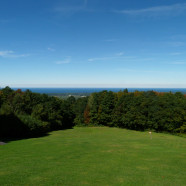Four toes, white belly, must be a: Four Toed Salamander!
Hello! I am a female Hemidactylium scutatum, or for those that prefer common names, four toed salamander. My name is quite literal as it refers to the fact that I only have four toes on my hind limbs whereas other amphibians typically have five. I am a member of the Plethodontidae family, so like my relatives I do not have lungs and rely on oxygen exchange through my wet skin. I happily live within moist woodlands throughout New York State, but I’m very secretive and hide myself near swamps, bogs, small ponds or seeps. During the spring, I will move to mossy areas to find a suitable...
Read MoreHemlock Woolly Adelgid
Hi there! For those of you that don’t know me, I am an Eastern Hemlock tree (Tsuga canadensis). I am a native tree that grows in the eastern part of the United States and Canada, and because of my size I am sometimes referred to as the “Redwood of the East.” I can reach upwards of 30 meters or roughly 100 feet in height and can live to be 800 or more years old. I have short, flat needles and long branches that reach up to the canopy and sweep down to the forest floor, creating unique micro-habitats for other species to utilize. Not to sound boastful, but I am a very...
Read MoreEaster Island’s history rewritten, previewing ours?
This post was inspired by this piece on NPR by Robert Krulwich detailing what happened on Easter Island – the old story and the supposed new story. Twan and I independently read this and had the similar thought (I love when that happens) of it being a good follow-up to my recently posted entry on climate change. You can read in detail about Easter Island on NPR but essentially the old tale tells of the inhabitants spending hundreds of years destroying the tiny remote island’s environment in order to feed themselves and prosper only to be left in ruin when it was all gone, slowly...
Read More






